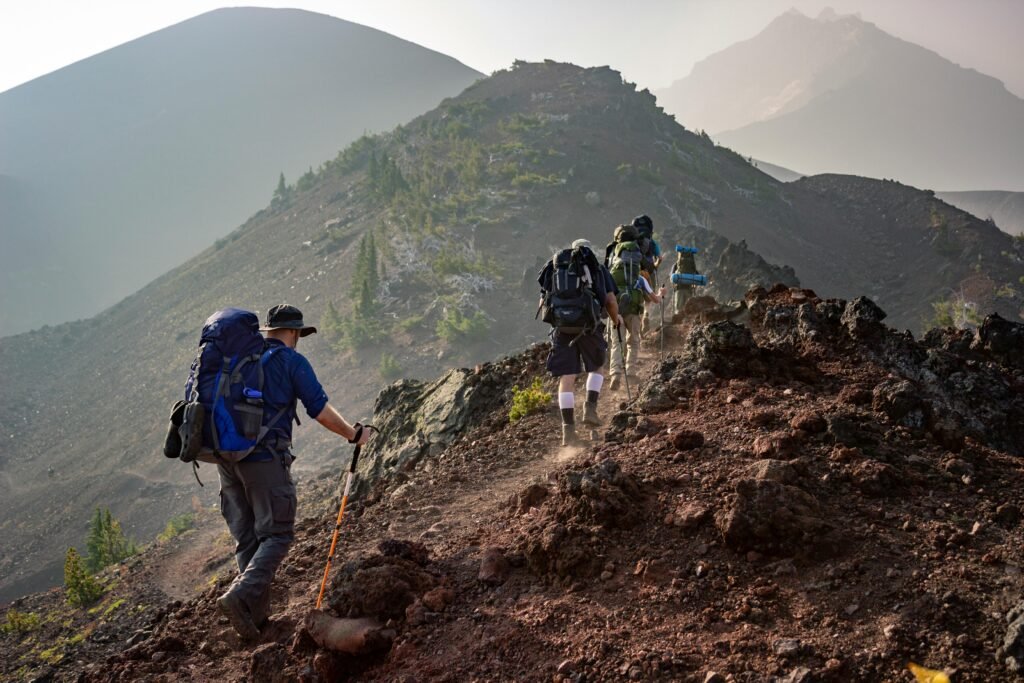Introduction to the Camino de Santiago
The Camino de Santiago, also known as the Way of St. James, is a historic pilgrimage route that leads to the shrine of the apostle Saint James the Great in Santiago de Compostela, Spain. Revered for centuries, this iconic path has long attracted countless pilgrims who seek spiritual growth and enlightenment along their journey. Its significance is deeply rooted in Christian tradition, symbolizing faith, devotion, and a quest for deeper meaning in life.
Historically, the Camino emerged as a major pilgrimage route during the medieval period, particularly after the remains of Saint James were believed to have been discovered in the early 9th century. This event marked the beginning of a spiritual movement that would see vast numbers of pilgrims embark on this route, traversing diverse landscapes and cultures. The trail encompasses various starting points across Europe, reflecting its inclusive nature and allowing individuals to undertake the journey from multiple locations based on their circumstances and beliefs.

Today, the Camino de Santiago has evolved, attracting not only devout pilgrims but also hikers and adventurers who seek a meaningful experience outside of religious affiliation. Each year, thousands lace up their boots to walk its trails, driven by a myriad of motivations, including personal reflection, adventure, and a desire for connection with fellow travelers. This remarkable pilgrimage offers an accessible path to rediscovery, healing, and introspection, all while fostering a sense of community amongst those who walk it.
As pilgrims navigate the Camino, they encounter historical sites, stunning landscapes, and rich cultural experiences, making the journey as enriching as the destination. With this multifaceted appeal, the Camino de Santiago remains one of the most celebrated and sought-after pilgrimage routes in the world, serving both as a spiritual journey and a metaphor for life’s path.
The Historical Significance of the Camino
The Camino de Santiago, known as the Way of St. James, has a rich history that traces back to the early Middle Ages. Its origins are closely linked to the discovery of the remains of Saint James the Greater, one of Jesus’ apostles, believed to have been buried in Santiago de Compostela, Spain. The initial reports of his tomb emerged in the 9th century, catalyzing the growth of pilgrimage to the site. Over the centuries, the Camino evolved from a singular route into an extensive network, serving as a vital spiritual and cultural pathway for countless pilgrims.
The significance of the Camino de Santiago in the Christian faith cannot be overstated. By the 11th century, it had cemented itself as one of the three primary pilgrimages in Christianity, alongside Jerusalem and Rome. Pope Calixtus II famously recognized Santiago de Compostela as the goal of pilgrimage in 1122, thereby elevating its status within the Christian community. The pilgrimage routes, marked by the iconic scallop shell symbol, provided a sense of direction and purpose for pilgrims, who sought not only spiritual redemption but also an opportunity to experience communal harmony.
Exploring the Various Routes
The Camino de Santiago, a pilgrimage routes leading to the tomb of Saint James in Santiago de Compostela, offers an array of paths each distinct in their characteristics and experiences. Among these, the Camino Francés stands out as the most popular route, spanning approximately 780 kilometers from Saint-Jean-Pied-de-Port in France to Santiago de Compostela. Pilgrims traverse through varied landscapes, from the imposing Pyrenees mountains to the lush plains of northern Spain, experiencing charming villages, rich history, and iconic landmarks such as the Gothic Cathedral in Burgos and the medieval city of León. The well-trodden path affords numerous facilities, making it an appealing choice for first-time pilgrims.
In contrast, the Camino Portugués offers an equally captivating yet distinct experience, stretching about 620 kilometers from Lisbon, Portugal, to Santiago de Compostela. This route allows pilgrims to immerse themselves in the cultural heritage of Portugal, featuring stunning coastal views along the way. The landscape shifts from urban environments to peaceful countryside, with several historical sites including the Roman cathedral of Porto. Travelers often choose this route for its quieter paths and a more intimate experience with local traditions.
Another notable route is the Camino del Norte, which runs along the northern coast of Spain, approximately 825 kilometers long. It is renowned for its dramatic coastal scenery and the rugged terrain of the Basque Country, making it a fantastic choice for those who seek both challenge and beauty. However, this route is less traveled than its counterparts, which can result in a more solitary journey. Pilgrims opting for the Camino del Norte often appreciate the chance to encounter stunning views of cliffs and the Atlantic Ocean.
The diversity of experiences across the various routes of the Camino de Santiago allows each pilgrim to find a path that resonates with their journey, whether in search of solitude, beauty, or cultural enrichment.
Key Landmarks Along the Journey
Walking the Camino de Santiago is not merely a physical journey; it is also an exploration of historical and cultural landmarks that narrate the rich tapestry of faith and humanity. One of the most significant locations is Santiago de Compostela, the final destination of the pilgrimage. The city’s cathedral stands as a magnificent centerpiece, housing the remains of Saint James, one of the apostles. This architectural marvel combines various styles, including Romanesque and Gothic, which draws countless visitors each year, eager to witness its grandeur and spiritual significance.
As pilgrims make their way, they often pause in the historic city of León. Known for its stunning Gothic cathedral, León offers an expansive collection of stained glass that dates back to the 13th century. The Quevedo Plaza, along with the San Isidoro Basilica, encapsulates the city’s charm and serves as a testament to its long-standing cultural importance in the region. Here, travelers can enjoy the local gastronomy, rich traditions, and vibrant atmosphere that characterizes this remarkable town.
Another notable stop along the Camino is Burgos, renowned for its impressive cathedral, which is recognized as a UNESCO World Heritage site. This Gothic masterpiece showcases intricate sculptures and stunning altars, captivating all who visit. Beyond its architectural wonders, Burgos has a bustling medieval district where pilgrims can stroll through quaint streets, absorbing the city’s unique blend of history and modern life. Each landmark along the Camino de Santiago serves as a testament to the pilgrims’ journey, intertwining faith, history, and culture into an experience that resonates deeply with all who walk the path.

Preparing for the Trek
Embarking on the Camino de Santiago requires careful preparation, both physically and mentally. It is essential for prospective pilgrims to start training well in advance of their journey. A tailored training routine should include regular walking sessions, gradually increasing the distance covered each week. Incorporating hikes with varied terrains can help build endurance and simulate the diverse paths encountered on the Camino. Additionally, strength training focusing on the legs and core is beneficial for maintaining stamina throughout the trek.
In regard to mental preparation, it’s important to establish a positive mindset and set realistic expectations. The Camino is not just a physical challenge; it’s also a spiritual journey that encourages reflection and personal growth. Pilgrims should consider journaling or engaging in mindfulness practices to cultivate a sense of calm and openness before embarking on this transformative experience.
Before starting the trek, ensure all important documents are organized. This includes a valid passport, a Pilgrim’s Passport (credencial), and any necessary travel insurance. A heartfelt consideration is to carry a guidebook or map to navigate the various routes efficiently. Acquainting oneself with local customs and cultural landmarks along the way can enrich the overall experience.
Accommodation varies widely along the Camino, with options ranging from albergues, which are hostel-style dormitories catering to pilgrims, to hotels offering more private accommodations. It is prudent to reserve beds in advance during peak seasons, especially in popular towns. Pilgrims can also budget their journey accordingly by considering their daily expenses, including lodging, meals, and miscellaneous costs. Creating a flexible budget will allow for a more enjoyable trekking experience and provide comfort throughout the pilgrimage.
What to Pack for the Camino
Preparing for the Camino de Santiago requires careful consideration of what to bring along on this challenging pilgrimage. The journey can span from several days to weeks, and being equipped with the right items is essential for a comfortable experience. First and foremost, selecting the right footwear is crucial. Invest in a sturdy pair of hiking boots or shoes that provide good ankle support and cushioning. It’s advisable to break them in before your journey to avoid blisters. Additionally, consider bringing a pair of comfortable sandals for evenings or resting periods.
Clothing should be lightweight, quick-drying, and suitable for layering, as temperatures can vary significantly throughout the day. A breathable moisture-wicking base layer, an insulating middle layer, and a waterproof outer layer are recommended. Moreover, packing a couple of pairs of trekking pants and shorts will provide versatility depending on the weather. Don’t forget to include a hat for sun protection and a buff or scarf for warmth or cooling purposes.
Gear essentials include a well-fitted backpack with a capacity between 40 to 50 liters, which is ample space for your belongings while remaining manageable. A sleeping bag suitable for various temperatures will ensure a comfortable night’s rest. Other vital items include a reusable water bottle to stay hydrated, a small first-aid kit for minor injuries, and a basic toolkit for gear maintenance.
When it comes to food, consider packing lightweight snacks such as nuts and dried fruits for energy boosts. It is important to practice efficient packing techniques by rolling clothes and using packing cubes to prioritize space. Ultimately, the goal is to minimize your load while ensuring you have all necessary items for your Camino experience. Remember, the less you carry, the easier the journey will be.

Cultural Experiences on the Camino
The Camino de Santiago offers pilgrims a unique opportunity to immerse themselves in a rich tapestry of cultural experiences. As they traverse the various routes, travelers encounter individuals from all walks of life, fostering connections that transcend linguistic and geographical boundaries. Meeting fellow pilgrims, each with their own stories and motivations, enhances the spiritual and personal aspects of the journey. These interactions often lead to shared meals, impromptu gatherings, and collaborative experiences that deepen the sense of camaraderie along the way.
In addition to connecting with other travelers, participants can engage with the local communities that line the Camino. Towns and villages welcome pilgrims with open arms, offering a glimpse into the daily lives of residents. Engaging with locals provides insights into regional history, traditions, and customs, enriching the overall experience. Visitors are often invited to local festivals, art exhibits, or traditional music performances that showcase the vibrant cultural heritage of each area.
One of the highlights of walking the Camino is the opportunity to taste authentic Spanish cuisine. Culinary delights vary by region, providing travelers with a gastronomic tour as diverse as the landscapes explored. From rustic eateries serving hearty stews to small cafés offering delectable pastries, each meal becomes part of the journey. Pilgrims can indulge in regional specialties such as “pulpo a la gallega” in Galicia or “pintxos” in the Basque Country, enhancing their appreciation for local gastronomy. These encounters not only satisfy the palate but also nourish the soul, contributing to the remarkable experience of walking the Camino de Santiago.
The Meditative Nature of the Walk
The Camino de Santiago is not merely a physical journey but also a profound spiritual and meditative experience that invites pilgrims to engage in self-reflection and mindfulness throughout their trek. As individuals traverse the diverse landscapes of this ancient pilgrimage route, they are given the space and time to contemplate their thoughts, emotions, and beliefs. Each step taken along the Camino serves as a reminder of both the path ahead and the path behind, facilitating a unique opportunity for introspection.
The rhythmic act of walking becomes a form of meditation, allowing the mind to settle and the spirit to awaken. The pilgrimage encourages a deep connection with nature, as pilgrims encounter breathtaking vistas, serene forests, and tranquil rivers that provide solace and inspiration. Many individuals report feelings of peace and clarity that arise from being immersed in the natural world, which can lead to heightened awareness and a sense of belonging. The quiet moments between encounters with fellow travelers also offer valuable opportunities for personal contemplation.
Conclusion: A Life-Changing Journey
The Camino de Santiago stands as a remarkable pilgrimage that transcends mere physical travel, offering participants an opportunity for profound personal and spiritual transformation. As many pilgrims have attested, walking this ancient route fosters significant personal growth characterized by reflection, self-discovery, and an unshakeable bond with others who share the journey. Each step taken along the Camino serves as a metaphorical step into one’s inner self, providing a space for contemplation and introspection.
Throughout the trek, individuals often experience a spiritual awakening, as the rhythm of walking allows for deep connections to emerge—whether with oneself, with nature, or with a higher power. This journey is not restricted to any one belief system, appealing to a diverse array of pilgrims. This inclusivity enriches the experience, enabling participants to gather insights from diverse backgrounds, fostering a spirit of camaraderie along the road. The shared stories, struggles, and triumphs encountered on the Camino create an unparalleled sense of community that is both comforting and invigorating.

Moreover, the physical endurance required for the Camino challenges one to confront personal limitations, inevitably leading to growth and resilience. Pilgrims are often inspired to embrace the transformative potential that lies not only in conquering miles but also in overcoming mental barriers. The journey encourages participants to let go of daily distractions and reconnect with their deepest values and aspirations, resulting in a clearer perspective on life’s purpose.
In summary, the Camino de Santiago embodies a life-changing experience for all who undertake it. Whether seeking spiritual enrichment or a chance to connect with like-minded individuals, the pilgrimage offers an undeniable transformation, making it a worthwhile endeavor for anyone open to the journey ahead.



